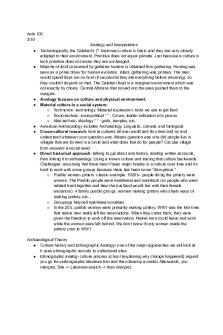Avatars, Monsters and Machines: A Cyborg Archaeology DOCX

| Title | Avatars, Monsters and Machines: A Cyborg Archaeology |
|---|---|
| Author | Colleen Morgan |
| Pages | 21 |
| File Size | 73.7 KB |
| File Type | DOCX |
| Total Downloads | 82 |
| Total Views | 173 |
Summary
Download Avatars, Monsters and Machines: A Cyborg Archaeology PDF
Description
European Journal of Archaeology Manuscript received 13 December 2018, revised 26 February 2019, accepted Avatars, Monsters and Machines: A Cyborg Archaeology COLLEEN MORGAN Department of Archaeology, University of York, UK As digital practice in archaeology becomes pervasive and increasingly invisible, I argue that there is a deep creative potential in practicing a cyborg archaeology. A cyborg archaeology draws from feminist posthumanism to transgress bounded constructions of past people as well as our current selves. By using embodied technologies to disturb archaeological interpretations, we can push the use of digital media in archaeology beyond traditional, skeuomorphic reproductions of previous methods to highlight ruptures in thought and practice. I develop this argument through investigating the avatars, machines, and monsters in current digital archaeological research. These concepts are productively liminal: avatars, machines, and monsters blur boundaries between humans and non-humans, the past and the present, and suggest productive approaches to future research. Keywords: digital archaeology, posthumanism, digital media, practice, cyborg archaeology INTRODUCTION Writing about the representation of prehistoric humans, Diane Gifford-Gonzalez (1993: 26) states that artists are mining arcane knowledge to make simulacra or 'science fictions' of archaeological evidence. The overt implication of this is that we are making fanciful, unreal representations of past things, people, and places when producing archaeological interpretations. Yet Gifford-Gonzalez is riffing on Donna Haraway (1989: 3), who notes that 'both science and popular culture are intricately woven of fact and fiction'—which share the same Latin root, facere, to make. Facts, Haraway states, are descendants of the past participle (factum), done, unchanging, 'fit only to be recorded'—as in artefacts—whereas 'fiction is an active form, referring to a present act of fashioning' (Haraway, 1989: 4) as in the act of interpretation, of storytelling. Following Gifford-Gonzalez and Haraway, I am not stating that archaeological...
Similar Free PDFs

Archaeology
- 2 Pages

Manifesto Cyborg Donna Haraway
- 24 Pages

La sonrisa del cyborg
- 2 Pages

Archaeology Dating Methods Essay
- 4 Pages

Archaeology in history
- 23 Pages
Popular Institutions
- Tinajero National High School - Annex
- Politeknik Caltex Riau
- Yokohama City University
- SGT University
- University of Al-Qadisiyah
- Divine Word College of Vigan
- Techniek College Rotterdam
- Universidade de Santiago
- Universiti Teknologi MARA Cawangan Johor Kampus Pasir Gudang
- Poltekkes Kemenkes Yogyakarta
- Baguio City National High School
- Colegio san marcos
- preparatoria uno
- Centro de Bachillerato Tecnológico Industrial y de Servicios No. 107
- Dalian Maritime University
- Quang Trung Secondary School
- Colegio Tecnológico en Informática
- Corporación Regional de Educación Superior
- Grupo CEDVA
- Dar Al Uloom University
- Centro de Estudios Preuniversitarios de la Universidad Nacional de Ingeniería
- 上智大学
- Aakash International School, Nuna Majara
- San Felipe Neri Catholic School
- Kang Chiao International School - New Taipei City
- Misamis Occidental National High School
- Institución Educativa Escuela Normal Juan Ladrilleros
- Kolehiyo ng Pantukan
- Batanes State College
- Instituto Continental
- Sekolah Menengah Kejuruan Kesehatan Kaltara (Tarakan)
- Colegio de La Inmaculada Concepcion - Cebu










